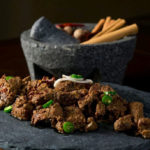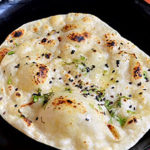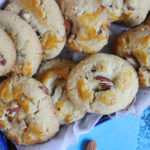Kausar Ahmed:
Project Feast Chef Instructor,
cookbook author, food stylist
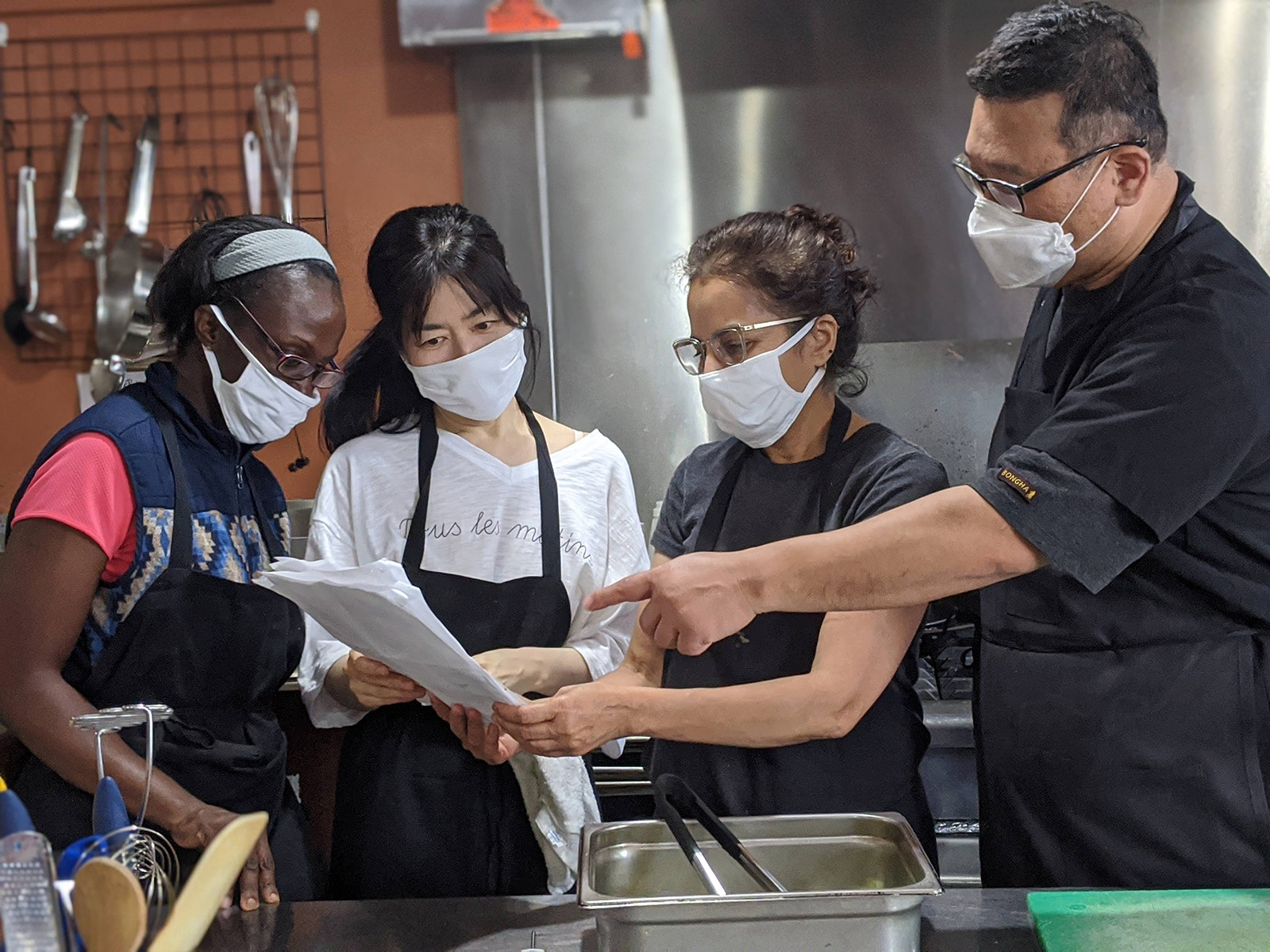
“It’s amazing how food can change lives.”
Kausar Ahmed has devoted her career to opening worlds through food and education, and has been Project Feast’s chef instructor since 2019. She’s also a cookbook author and food stylist who teaches aspiring cooks from around the world.
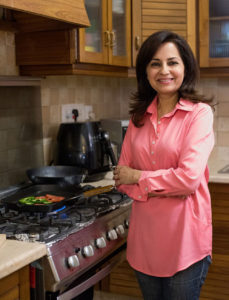 A well-worn skillet is Kausar Ahmed’s palette this morning in the Ubuntu Street Café kitchen. The chef drops in swatches of golds, reds and browns – mace, coriander seeds, turmeric, star anise, dundicut chili powder, cinnamon, nutmeg, cinnamon and fennel seeds – and swirls them into a richly hued blend over a low flame. After a few minutes, the spices take on a deeper color and lightly toasted scent, and she sets the pan aside to cool.
A well-worn skillet is Kausar Ahmed’s palette this morning in the Ubuntu Street Café kitchen. The chef drops in swatches of golds, reds and browns – mace, coriander seeds, turmeric, star anise, dundicut chili powder, cinnamon, nutmeg, cinnamon and fennel seeds – and swirls them into a richly hued blend over a low flame. After a few minutes, the spices take on a deeper color and lightly toasted scent, and she sets the pan aside to cool.
This intoxicating aroma has drawn Kausar to the kitchen since she was a child in Karachi, watching her grandmother roast whole spices and grind them by mortar and pestle. Now, she uses the same spices to teach immigrant and refugee cooks in Project Feast’s kitchen in Kent. “When you know your spices, the world opens up to you,” she says.
Kausar has devoted her career to opening worlds through food and education. In Pakistan, she first taught cooking classes to children out of her home – and she still runs a program there teaching culinary skills to low-income women recovering from abuse and addiction. For years, she had a televised cooking show, with an off-camera team discreetly offering counseling to women in need. Kausar is an internationally sought-after food stylist and author of The Karachi Kitchen cookbook. And since summer 2019, she has been Project Feast’s chef instructor charged with shepherding apprentices on their path to employment in Western Washington’s food industries.
On a winter morning before making chicken tikka masala, Kausar took time to reflect on the love for food instilled by her family, her journey through a career that wound from Karachi to California to Seattle, and her plans to expand options for Project Feast apprentices:
“FROM CHILDHOOD, I WAS SURROUNDED WITH FOOD, starting with my grandmother. My mom’s mother was a powerhouse, and she has been my inspiration for so many things. She practically had it written on her, ‘Don’t mess with me.’ She made the most delicious food. I remember specifically her meatballs and the spices. I remember the stories.
She immigrated from India at Partition. I remember her food laid out on the floor traditionally with a long mat, everybody sitting around it. She would go for a walk every day and come back with people she met on the way, so we were used to having different people sitting around us. My love for different cultures, cuisines and religions started there.
Then there was my father’s mom. She was from Bombay – Mumbai now. She made amazing lentils, amazing fish. There would be at least six types of pickles and chutneys.
And my mom and my father were real foodies. My father was a chemical engineer and a well-known scientist and educator. He set up institutes and colleges, and traveled a lot for workshops and conferences. My mom was fortunate to travel the world with him, so they got a lot of exposure to different foods and cultures.
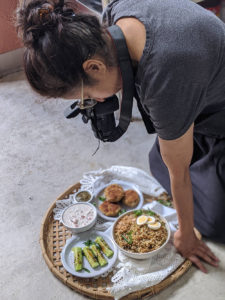
Kausar includes an introduction to food photography in her work with Project Feast apprentices.
My mother would experiment with foods. There was a bakery that had a famous Black Forest cake and she loved it. In our neighborhoods, we had traditional tandoors – clay ovens where they made the naan. One day she had cake pans full of batter and she went to the tandoor and told the guy to put it in. He thought she was crazy but he couldn’t refuse. She did that until she got the sponge perfect.
These are the memories. Cooking and food were in my bloodstream.
“AS I GREW UP, I was cooking for family, but I had not thought of going into food for work. My father was eager that I go into education, so I did my early childhood education and started teaching. When I got married and had kids, I gave cooking classes from home.
And then, my sister-in-law owned an advertising company, and I was a client executive for many years. They did a lot of TV commercials, so I did food for them. Once I made around 600 drumsticks to get the right shot. Food was connected with everything I did.
When they opened a TV channel, I said, ‘Let’s start cooking shows because we need to empower a lot of women.’ I had a live cooking show for three years. My deal was that I would do the show and take call-ins, but I also wanted to help women who need help. I set up an offline team with a lawyer and a therapist. We had to do it offline because you don’t get sponsors for such things. When women would call in, I would say, ‘Oh, just call after the show and I will give you the recipe.’ It’s amazing how food can change lives.
When my three kids came to the U.S., one by one for college, I started coming. I wanted to do food styling professionally. When my oldest daughter was in L.A., I walked in to Sur La Table and I saw they had classes and there was a chef. I said, ‘Can I assist you?’ He was a little shocked. He listened and said, “You are so passionate. I would love to see how you like it, and let me see how I like it.” I started assisting him and I learned.
I catered with him for Martha Stewart. When he introduced me to the huge crowd, he said, ‘I want you guys to meet the Martha Stewart of Pakistan!’ I thought I would die! He said, ‘You have amazing talent.’ He was really inspiring.
When my daughter moved to San Francisco, I started working there in a school program called Cooking Round the World. And then I had to go back to Pakistan, so I took the program and introduced it into schools. And I was doing my food styling. I am still the only professional food stylist in Pakistan. I work with every brand from Pepsi to Unilever to Nestlé. I always wanted to take a path that nobody else has taken.
My oldest daughter got married to an amazing boy who is from Seattle, and they decided to move here, so I moved here. My mom is also with me.
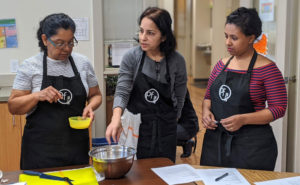
Kausar leads a Project Feast class before the pandemic struck.
“AT THIS STAGE IN LIFE, I was hoping to find work I love to do. I came across the Project Feast job, and I thought, ‘Oh, this looks very interesting to work with refugees.’ In Pakistan I worked with low-income women, so the mission is close to my heart.
And the students have taught me a lot. They’ve showed how they can cope with difficult situations and be persistent and complete what they have started. It’s so inspiring to hear each story of where they came from, what they are coping with, how positive they are.
I saw the way they opened up and started sharing their recipes and flavors. I learned so much about Somali food and Mexican food. And I taught them about techniques I learned professionally and that my grandmother taught me – like how ginger can be an amazing marinade to make meat tender. I like to introduce the spices that we use in Pakistan. Each culture has different chilies.
We are working on expanding the curriculum. We are going to add baking and cake decorating because those are important industries with jobs. We are teaching them how to set up their own businesses, how to get permits. We want to incorporate job shadows. I am also introducing them to food photography and styling.
I’ve seen that it’s easier for men to be able to go out and work. For women who are taking care of kids – instead of getting a job, they would rather set up a business. I would rather they do a job first to get experience before they set up a business. That is a huge challenge.
We want to be a part of the students’ entire journey. We want to see them get a job when they step out of here. The food, the stories and the culture – they already have this. We get to share it, and we hope to share it with the world.
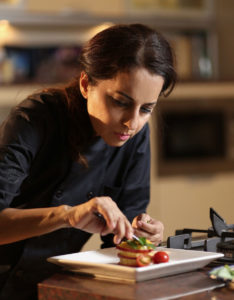
Kausar’s food-styling expertise is sought after by multinational companies.
“LIKE EVERYONE ELSE, the pandemic hit me hard. Our program shut down for a brief period, my travel plans to teach got canceled, my in-person cooking classes got canceled and life in general just stopped. Now, I’m somebody who does not give up. Life has taught me that if one path or door closes, you don’t just sit and brood. You get up and find another path or door that could be an even better alternative. All you have to do is work hard, be persistent – and most importantly, be positive.
I worked hard to learn more about technology to set up Zoom classes and have moved from in-person classes to virtual classes on two major platforms: Airbnb Experiences and ChefsFeed. I have guests from all over the world sign up for my classes. It has been a fabulous and life-changing experience for me.
Another special aspect of this lockdown has been to reflect on life in general. It gave me time to be even more thankful for all the wonderful people in my life, and all the blessings.”
– Interview lightly edited for length and clarity.
Interview and writing by Denise Clifton, Tandemvines Media
Dum Kay Pasanday (Masala-rubbed Roast Beef Tenderloin)
Ingredients
Ingredients for spice rub
- 1 1/2 tsp black peppercorns
- 1 1/2 tsp coriander seeds
- 1 1/2 tsp cumin seeds
- 1 1/2 tsp mustard seeds
- ½ tsp whole cloves
- ½ tsp fennel seeds
- 4 green cardamom pods
- 1 cinnamon stick (about 1½-inches long), broken into small pieces
- 2 tbsp coconut flakes
- 10 to 12 whole red chilies, dry
- 1 1/4 tsp salt
Ingredients for beef
- 2 pounds beef tenderloin, trimmed and chopped into thin slices of 2-inch filets
- 1/2 cup plain yogurt
- 1 tbsp lemon juice
- 2 tsp ginger paste
- 1 tsp garlic paste
- 1 cup water
- 1 1/2 tbsp vegetable oil
- 1 medium onion, finely sliced
Ingredients for garnish
- 1 red or white onion, chopped
- 1 fresh green chili, sliced and seeded
- 1/2 cup fresh cilantro, chopped
- 1 tbsp ginger, finely julienned
- 1 lemon, sliced
Instructions
- 1. Toast spices in a dry skillet over medium-low heat for 3 to 5 minutes, stirring occasionally, until mustard seeds begin to pop. Cool completely and then grind into a powder.
- 2. In a large bowl, mix the beef, yogurt, lemon juice, ginger and garlic pastes, and spice mix. Marinate for 2 to 3 hours, or overnight for best results.
- 3. Heat oil in a large skillet or Dutch oven over medium heat. Add onion slices and fry until golden brown. Add the marinated beef and water; mix well and cover. Cook on a stove on low heat for 2 to 3 hours until the meat is completely tender and juices have soaked into the meat.
- 4. Stir fry the meat on medium heat for 2 to 3 minutes ( This is a very important part of our cooking process to bring out the flavors)
- 5. Garnish with onion, green chili, cilantro, ginger and lemon.
- Serve hot with naan.
Kulcha Bread
Ingredients
- 2 1/2 cups all purpose flour
- 1/2 tsp baking powder
- 1/4 tsp baking soda
- 2 tsp sugar
- 3/4 tsp salt
- 4 tbsp whole milk yogurt
- 2 1/2 tbsp ghee or oil
- 3/4 cup room temperature water for kneading (Note: I measure exact amount. Add more if needed – or if the dough is too wet, add more flour. All flour textures are different and require different levels of moisture.)
- Extra flour for dusting
- 1 tbsp nigella seeds
- 1/2 cup ghee or softened butter, for frying
Instructions
Making the dough
- 1. In a large bowl mix the flour, salt, sugar, baking powder and baking soda.
- 2. Make a well in the center. Add the yogurt, oil and water.
- 3. Mix the flour with the liquids first and then start to knead. Make a smooth and soft dough.
- 4. In the same bowl, cover the dough with a dry or moist ( should not be wet) kitchen towel and let the dough ferment for 2 hours.
Rolling and making the kulcha
- 1. Divide the dough into 8 pieces and roll into balls. Set aside, covered wit a kitchen towel (Size of balls can vary according to personal preference)
- 2. Sprinkle some nigella seeds on the board or counter and roll seeds on to each ball.
- 3. Flatten a dough ball with your fingertips.
- 4. With a rolling pin, roll a thin kulcha, round or oval.
- 5. Heat a griddle or a tava on medium heat. Place the kulcha on the griddle..
- 6. Cook one side till it is a quarter of the way cooked, about two minutes. Flip and cook the other side till it is half-cooked, about 4 minutes. (Turn the heat down if it’s too hot.)
- 7. Apply about /4 tsp of ghee or butter on both sides of kulcha while cooking, and keep pressing with a spatula.
- 8. Cook till kulcha is golden and evenly cooked.
- Repeat to make all the kulchas. Serve hot.
Nan Khatai (Traditional Shortbread Cookies)
Ingredients
- 1 cup all-purpose flour
- 1 cup chickpea flour
- 1 tbsp semolina
- 1 cup granulated sugar (170g or 6 oz)
- 1 cup ghee or unsalted butter, at room temperature (125g or 4.35 oz)
- 1 cup whole almonds
- 1 tsp ground cardamom
- 1/2 tsp baking powder
- 2 large egg yolks, whisked
Instructions
- 1. Preheat the oven to 350°F and set aside a parchment-lined baking sheet.
- 2. In a large bowl, combine all-purpose flour, sugar, ghee/butter, almonds, ground cardamom and baking powder. Mix until thoroughly combined and a cohesive dough comes together.
- 3. Spoon the dough out using a cookie scoop or about 2 tablespoons of dough, and roll into balls (or as I do, weigh it on a scale to get a consistent size). Place spaced 2 inches apart on the baking sheet. (You do not need to flatten them) Brush the tops with whisked egg yolk.
- 4. Bake until the edges are just barely golden, about 10 to 15 minutes. (Cookies will set once cooled). Cool completely on the baking sheet.

